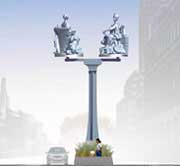|
March 12, 2009
Art, People Triumph Over Traffic in $23 Million Brooklyn Rehab
Commentary
by Mike Di Paola
March
12 (Bloomberg) -- New York developer Robert Moses favored cars
over people in the 1960s, when he tore down the art- filled plaza that
greeted pedestrians approaching the Brooklyn entrance of the Manhattan Bridge.
These days, it’s not worth the risk to life
and limb to linger at this bleak, congested approach to the span that crosses
the East River, linking two great boroughs. Just in time for the bridge’s 100th
birthday, artist Brian Tolle is busy rectifying this unhappy situation. “It is becoming a new kind of public
space,” Tolle said, wearing black overalls and a scarf in his chilly
Williamsburg studio. “When Robert Moses demolished the plaza in the 60s, I
think the attitude was that art got in the way of progress.” In 2007, Tolle won a Design Award
from New York
City and with it the commission to create a permanent installation at the
bridge -- a work that should help reclaim the area for human beings. Tolle
is constructing near-replicas of a pair of sculptures by Daniel Chester
French. The allegorical figures representing Manhattan and Brooklyn in female
form sat at the bridge’s entrance from 1916 until 1963. Manhattan
sits upon a chest, holding a winged globe -- a symbol of power -- with a
peacock at her side. Her bearing is more regal than that of Brooklyn, who
wears a laurel wreath and sits next to a boy reading, a church and a lyre. The
sculptures were moved to the Brooklyn Museum’s entrance to accommodate more automobiles
and the revamping of the bridge plaza. Don’t
Walk |
|
|
Moses rarely had pedestrians in mind when he remade New
York. He was a tireless champion of the automobile, although he himself never
drove. Moses deserves credit for much of New York’s urban development in the
20th century, as well as much of the blame for snuffing out neighborhoods
with roadways. Tolle’s replicas will preside over one end of Flatbush
Avenue, which is itself poised for a broader, $23 million makeover. The city
plans to break ground in late spring on a project to beautify the
three-quarters of a mile between the bridge entrance and Lafayette Street. The Flatbush Avenue Streetscape project aims to green
up the chaotic, car-centric thoroughfare that leads to the bridge. The city
plans to repair and broaden the sidewalks and build a median strip for
pedestrians -- with shade trees, park benches and better lighting. Symbolic Beacon Tolle is known for his more somber, contemplative “Irish
Hunger Memorial” in Battery Park City, Manhattan, a half-acre landscaped
construction using soil, plants and rocks from every county in Ireland. While
that work remembers a solemn past, his bridge project will illuminate the
present symbiosis between the boroughs. “It will function symbolically as kind of a beacon
entrance. The moment you step on Brooklyn soil, you’ll be greeted by this,”
Tolle says, pointing to a computer animation of his piece. His renditions approximate the size of the originals --
11 1/2 feet tall. Since his pieces will be closer together than French’s had
been, he may decide to shrink them down to about 10 feet, in order to
maintain the originals’ relative proportions. Two aspects of the work are striking. Tolle is
sculpting his pieces out of polyester resin, a translucent material to be lit
from within to create an icy blue illumination. (The originals are gray
granite). Statues in Motion Also notable, these statues are in motion. Linked by a
platform which sits on a 24-foot tower of steel, the pieces revolve around
each other, their movement symbolic of the dynamic relationship between the
two boroughs. The steel tower will be painted in the same powdery blue as the
real bridge and will taper at the foot to suggest the actual structure’s
form. “In my configuration, there’s a level of engagement
between (the statues) that couldn’t have been achieved in the earlier
interaction,” Tolle said. “They are linked together.” Tolle hopes to have his installation completed in time
for the Manhattan Bridge centennial celebrations in July. The overall
beautification project will likely take two years to complete. Tolle says that’s a good thing: “They’re actually
clearing space for art, rather than getting rid of it to make room for a new
roadway.” Not only room for art, but for people -- pedestrians,
bicyclists, and anyone who wants a moment on a park bench. Hopefully, we’ll continue to see this shift in
priorities intensify as infrastructures designed for automobiles are replaced
or retrofitted with more human touches. Tolle’s
“Levittown,” a playful homage to the nation’s first mass-produced suburb,
is on view through March 21 at the CRG Gallery on West 22nd Street in
Manhattan. For more information: http://www.crggallery.com. (Mike
Di Paola writes about preservation and the environment for Bloomberg
News. The opinions expressed are his own.) To contact the writer of this column: Mike
Di Paola at mdipaola@nyc.rr.com.
Last Updated: March 12, 2009 00:00 EDT |
|
|
